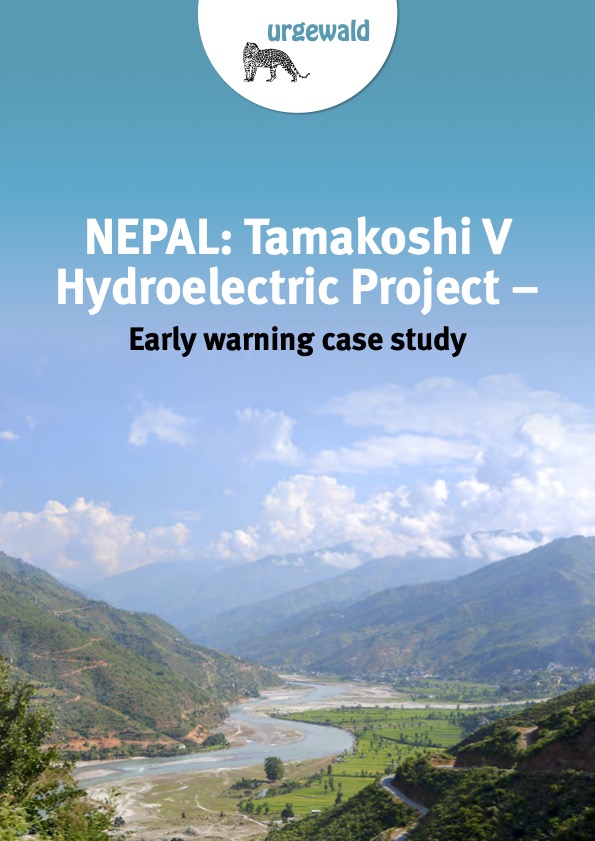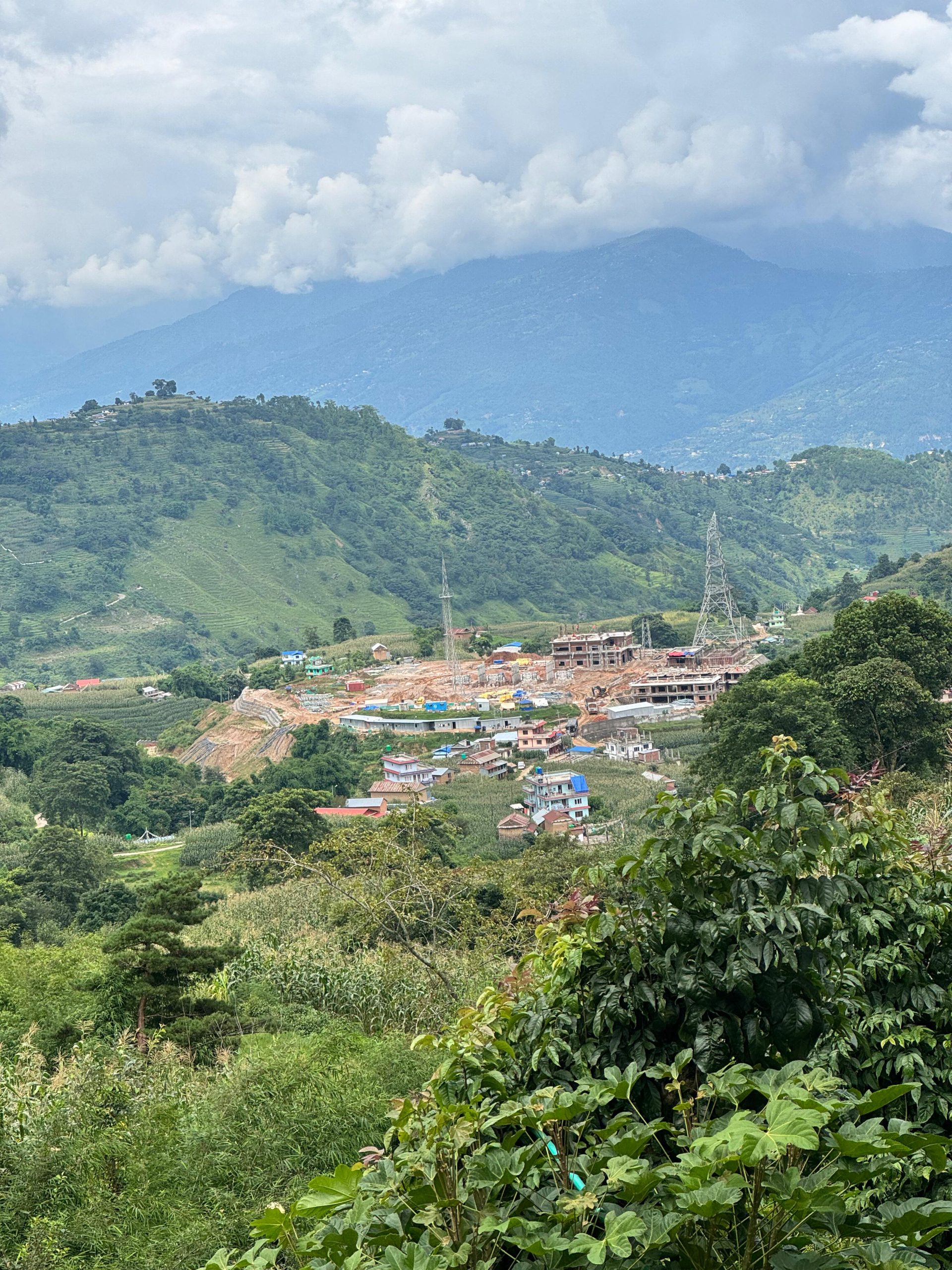काठमाडौंको उत्तरपूर्वमा अवस्थित शङ्खरापुर नगरपालिकाको बोझेनीका आदिवासी तामाङ र स्थानीय समुदायले आज एसियाली विकास बैंक (एडीबी) को जवाफदेहिता संयन्त्रको अनुपालन समीक्षा प्यानल (सीआरपी) मा उजुरी दर्ता गरेका छन्। उजुरीमा उनीहरूले बोझेनीमा निर्माणाधीन तामाकोशी-काठमाडौं २२०/४०० केभी प्रसारण लाइन र यसको सवस्टेसन स्थानान्तरण हुनुपर्ने उनीहरुको मागको सम्बन्धमा एडीबीको सुरक्षण नीति र कार्यविधि पालना भएको सुनिश्चित गर्न सीआरपीलाई अनुरोध गरेका छन्।
more “तामाकोशी-काठमाडौं प्रसारण लाइनबाट प्रभावित आदिवासी तामाङ तथा स्थानीय समुदायद्वारा एडीबीको अनुपालन समीक्षा प्यानलमा उजुरी”Tag: Tamakoshi-Kathmandu Transmission Line
Indigenous Tamang and local communities affected by Tamakoshi-Kathmandu Transmission Line file complaint to ADB’s Compliance Review Panel
Indigenous Tamang and local communities of Bojheni in Shankharapur municipality in the northeast of Kathmandu filed a complaint today with the Compliance Review Panel (CRP) of the Asian Development Bank’s (ADB) Accountability Mechanism. In the complaint, they have requested the CRP to ensure ADB’s Safeguards policy and procedural compliance in relation to their demands of relocation of the Tamakoshi–Kathmandu 220/400 kV Transmission Line and its substation in Bojheni being forcefully constructed on their lands.
more “Indigenous Tamang and local communities affected by Tamakoshi-Kathmandu Transmission Line file complaint to ADB’s Compliance Review Panel”Tamakoshi V Hydroelectric Project: Early Warning Case Study
This case study on the Tamakoshi V Hydroelectric Project aims to analyze the impacts of the Project during its early stages of implementation in order to identify potential gaps in the accountability framework for the Project in line with the policies of its financier Asian Infrastructure Investment Bank (AIIB) as well as wider impacts of the Project in the context of cumulative impacts of the cascade dams being built or planned in the Tamakoshi River. Further, the case study seeks to look into the Project to determine if it is in line with the environmental sustainability and fiscal stability of Nepal.

The case study calls for calls for serious reassessment of the Project on the grounds of outdated feasibility study and inadequate information disclosure, lack of participation and consent of the affected communities, and potential cumulative environmental harms, among other concerns. It is based on desk review of the official Project documents, relevant policies of the AIIB and laws and policies of Nepal as well as media, governmental and non-governmental reports on the Project and other associated projects. While CEMSOJ has made initial efforts to reach out to the affected communities of the Project to understand their perspectives of and aspirations with the Project at the ground level, lack of such information gathered so far poses a major limitation for this study . In order to address that, it is planned that this study will later be complemented by field visits to the affected communities.
more “Tamakoshi V Hydroelectric Project: Early Warning Case Study”Nepal: Stop State brutality against the Indigenous Tamangs and other Locals for the construction of Tamakoshi-Kathmandu 220/400 kV Transmission Line Project in Shankharapur, Kathmandu
CEMSOJ joins organizations and individuals worldwide in the following public statement issued to the concerned authorities of Nepal and the Asian Development Bank (ADB).
Nepal: Stop State brutality against the Tamang Indigenous Peoples and Locals

Stop the construction of Tamakoshi-Kathmandu 220/400 kV Transmission Line Project in Shankharapur-3, Kathmandu
We, the undersigned organizations and individuals, strongly condemn the ongoing repression by Nepal’s police and armed police forces on the indigenous Tamang and other locals in Bojheni village, Shankharapur municipality Ward no. 3 in the northeast of Kathmandu for the construction of Tamakoshi-Kathmandu 200/400 kV Transmission Line and its substation.
more “Nepal: Stop State brutality against the Indigenous Tamangs and other Locals for the construction of Tamakoshi-Kathmandu 220/400 kV Transmission Line Project in Shankharapur, Kathmandu”Tamakoshi-Kathmandu Transmission Line affected communities call on the Asian Development Bank to realign the power line and relocate its sub-station
3 November 2021, Kathmandu
Indigenous Tamang and other locals of Shankharapur municipality in the northeast of Kathmandu affected by the Tamakoshi-Kathmandu 200/400 kV Transmission Line and its Bojheni substation today submitted a memorandum to the Asian Development Bank (ADB) Nepal Resident Mission. They have called for realignment of the Transmission Line and shifting of the sub-station from their settlement area as planned under the ADB-financed Electricity Transmission Expansion and Supply Improvement Project.
In the memorandum emailed to the ADB with signatures of more than 200 affected locals, the Upper Tamakoshi Hydropower Project Victims’ Struggle Society has alleged that they have not been adequately informed about the impacts of the Transmission Line and the sub-station and the land acquisition has been undertaken through intimidation of the landowners. The construction of the Transmission Line and its sub-station has been halted for the last two years due to the opposition of the locals. They allege that the Project is seeking to construct the Bojheni substation in an unauthorized manner without agreement of the locals. Further, the Transmission Line running over their houses, lands and religious and cultural sites will devaluate their properties, significantly affect their livelihoods dependent on agriculture and tourism as well as the environment and even cause insecurity to their health and lives, which will eventually displace them from their ancestral lands and settlement.
more “Tamakoshi-Kathmandu Transmission Line affected communities call on the Asian Development Bank to realign the power line and relocate its sub-station”तामाकोशी-काठमाडौं प्रसारण लाइन पिडित समुदायद्वारा प्रसारण लाइन र त्यसको सबस्टेशन स्थानान्तरण गर्न माग गर्दै एसियाली विकास बैंकलाई ज्ञापनपत्र बुझाइयो
३ नोवेम्बेर २०२१ (वि. सं. २०७८ कार्तिक १७), काठमाडौँ
तामाकोशी–काठमाडौं २००/४०० के.भी. प्रसारण लाइन र त्यसको बोझेनी सवस्टेशनबाट पिडित काठमाडौंको उत्तरपूर्वस्थित शंखारापुर नगरपालिकाका आदिवासी तामांग र अन्य स्थानीयहरुले एसियाली विकास बैंक (एडीबी) को नेपाल आवासीय मिसनलाई आज ज्ञापनपत्र बुझाएका छन्। उनीहरुले एडीबीको सहयोगमा कार्यन्वयन भइरहेको Electricity Transmission Expansion and Supply Improvement Project अन्तर्गतको प्रसारण लाइन र त्यसको सवस्टेसन उनीहरुको बस्ती क्षेत्रबाट स्थानान्तरण गरी अन्तै सार्नको लागि आह्वान गरेका छन्।
२०० भन्दा बढी पिडित स्थानियहरुको हस्ताक्षर सहित एडीबीलाई ईमेल मार्फत बुझाइएको ज्ञापनपत्रमा अप्पर तामाकोसी जलविद्युत् परियोजना पिडित संघर्ष समाजले प्रसारण लाइन र सब स्टेशनको प्रभावबारे पर्याप्त जानकारी नगराएको र जग्गाधनीहरुलाई डर धम्की देखाई जग्गा अधिग्रहण गरिएको भनिएको छ। स्थानीयहरुको विरोधका कारण विगत दुई वर्षदेखि प्रसारण लाइन र सबस्टेसन निर्माणको काम रोकिएको छ। आयोजनाले स्थानीयको सहमतिविना अनधिकृत रुपमा बोझेनी सबस्टेसन निर्माण गर्न खोजेको उनीहरुको आरोप छ। यसबाहेक, उनीहरूको घर, जग्गा र धार्मिक तथा सांस्कृतिक स्थलहरू माथिबाट तानिने प्रसारण लाइनले उनीहरुको सम्पत्तिको अवमूल्यन हुने, कृषि र पर्यटनमा आश्रित उनीहरूको जीविकोपार्जन तथा वातावरणमा ठूलो असर पर्ने र उनीहरूको स्वास्थ्य र जीवनमा असुरक्षासमेत निम्त्याउने ज्ञापनपत्रमा भनिएको छ। फलस्वरूप, पिडित आदिवासी र स्थानीय समुदाय आफ्नो पुर्ख्यौली जग्गा जमिन र बासस्थानबाट विस्थापित गर्ने ज्ञापनपत्रमा उल्लेख छ।
more “तामाकोशी-काठमाडौं प्रसारण लाइन पिडित समुदायद्वारा प्रसारण लाइन र त्यसको सबस्टेशन स्थानान्तरण गर्न माग गर्दै एसियाली विकास बैंकलाई ज्ञापनपत्र बुझाइयो “